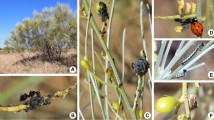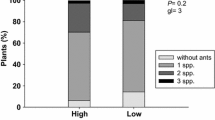Abstract
Exotic plants are involved in different interactions with the fauna of the invaded sites, which can facilitate or limit their successful establishment and spread. Here, we evaluated the impact of native aphid-tending ants on the reproductive consequences of the invasive thistle Carduus thoermeri in NW Patagonia, which is frequently infested by aphids. We estimated the number and proportion of viable seeds, seed weight, germination proportion, and mean germination time of thistles in the presence and absence of aphids and ants, and with or without pollinator access. Aphid-infested thistles had 57% less viable seeds and 29% lower seed weight than non-infested thistles. Although ants and aphids had no effect on germination proportion, the mean germination time was ca. 15% faster in seeds from aphid-infested thistles. Our results suggest that the potential indirect effects of aphid-tending ants on thistles (negative effects via pollinator deterrence and positive effects via driving away non-aphid herbivores) are less important than the direct negative effects of aphids. Interestingly, although harboring aphids and ants has negative reproductive consequences for C. thoermeri plants, it could also generate a competitive advantage by giving rise to small and fast germinated seeds. This study illustrates the complexity of novel interactions among exotic plants and native ants, reinforcing the need for more studies to fully understand the potential impact of ant–plant interactions mediated by Hemiptera on the invasion success of plants.




Similar content being viewed by others
References
Bates D, Mächler M, Bolker B, Walker S (2014) Fitting linear mixed-effects models using lme4. J Stat Softw 67:1–48. https://doi.org/10.18637/jss.v067.i01
Bazzaz FA, Chiariello NR, Coley PD, Pitelka LF (1987) Allocating resources to reproduction and defense. Bioscience 37:58–67. https://doi.org/10.2307/1310178
Blackman R, Eastop V (1984) Aphids on the worlds crops: an identification guide. Wiley, New York
Blancafort X, Gómez C (2005) Consequences of the Argentine ant, Linepithema humile (Mayr), invasion on pollination of Euphorbia characias (L.) (Euphorbiaceae). Acta Oecol 28:49–55. https://doi.org/10.1016/J.ACTAO.2005.02.004
Bolker B, Skaug H, Magnusson A, Nielsen A (2016) Getting started with the glmmADMB package. R-Forge
Canedo-Júnior EO, Santiago GS, Zurlo LF et al (2017) Isolated and community contexts produce distinct responses by host plants to the presence of ant-aphid interaction: plant productivity and seed viability. PLoS ONE 12:e0170915. https://doi.org/10.1371/journal.pone.0170915
Chamberlain SA, Holland JN (2009) Quantitative synthesis of context dependency in ant–plant protection mutualisms. Ecology 90:2384–2392. https://doi.org/10.1890/08-1490.1
Correa M (1999) Flora patagónica. Colección Científica. INTA, Buenos Aires
Crawley MJ (1989) Insect herbivores and plant population dynamics. Annu Rev Entomol 34:531–562. https://doi.org/10.1146/annurev.en.34.010189.002531
Davidson DW, Mckey D (1993) Ant-plant symbioses: stalking the Chuyachaqui. TREE 8:326–332
de Briano AE, Acciaresi HA, Briano JA (2013) Establishment, dispersal, and prevalence of Rhinocyllus conicus (Coleoptera: Curculionidae), a biological control agent of thistles, Carduus species (Asteraceae), in Argentina, with experimental information on its damage. Biol Control 67:186–193. https://doi.org/10.1016/J.BIOCONTROL.2013.07.009
de Vega C, Herrera CM (2013) Microorganisms transported by ants induce changes in floral nectar composition of an ant-pollinated plant. Am J Bot 100:792–800. https://doi.org/10.3732/ajb.1200626
Dimitri M (1962) La flora andino-patagónica. Anales de Parques Nacionales, Argentina
Elton C (1958) The ecology of invasions by animals and plants. University of Chicago Press, Chicago
Farji-Brener AG, Ghermandi L (2008) Leaf-cutting ant nests near roads increase fitness of exotic plant species in natural protected areas. Proc Biol Sci 275:1431–1440. https://doi.org/10.1098/rspb.2008.0154
Farji-Brener AG, Gianoli E, Molina-Montenegro MA (2009) Small-scale disturbances spread along trophic chains: leaf-cutting ant nests, plants, aphids, and tending ants. Ecol Res 24:139–145. https://doi.org/10.1007/s11284-008-0491-3
Fiala B, Meyer U, bin Hashim R, Maschwitz U (2014) Temporary sterilization behavior of mutualistic partner ants in a Southeast Asian myrmecophyte. Ecol Res 29:815–822. https://doi.org/10.1007/s11284-014-1161-2
Floate KD, Whitham TG (1994) Aphid–ant interaction reduces chrysomelid herbivory in a cottonwood hybrid zone. Oecologia 97:215–221. https://doi.org/10.1007/BF00323152
Fox J, Weisberg S, Price B, et al. (2018) Package “car.”
Franzel C, Farji-Brener A (2000) ¿Oportunistas o selectivas? Plasticidad en la dieta de la hormiga cortadora de hojas Acromyrmex lobicornis en el noroeste de la Patagonia. Ecol Austral 10:159–168
Gobbi M, Puntieri J, Calvelo S (1995) Post-fire recovery and invasion by alien plant species in a South American woodland-steppe ecotone. In: Post-fire Recover invasion by alien plant species a South Am woodland-steppe ecotone, p 105–115
Gonzálvez FG, Santamaría L, Corlett RT, Rodríguez-Gironés MA (2013) Flowers attract weaver ants that deter less effective pollinators. J Ecol 101:78–85. https://doi.org/10.1111/1365-2745.12006
Gosper CR, Vivian-Smith G (2006) Selecting replacements for invasive plants to support frugivores in highly modified sites: a case study focusing on Lantana camara. Ecol Manag Restor 7:197–203. https://doi.org/10.1111/j.1442-8903.2006.00309.x
Heil M, McKey D (2003) Protective ant–plant interactions as model systems in ecological and evolutionary research. Annu Rev Ecol Evol Syst 34:425–553. https://doi.org/10.1146/annurev.ecolsys.34.011802.132410
Hoffmann JH, Moran VC (1998) The population dynamics of an introduced tree, Sesbania punicea, in South Africa, in response to long-term damage caused by different combinations of three species of biological control agents. Oecologia 114:343–348. https://doi.org/10.1007/s004420050456
Hull A, Evans J (1973) Musk thistle (Carduus nutans): an undesirable range plant. J Range Manag 26:383–385. https://doi.org/10.2307/3896865
Ibarra-Isassi J, Oliveira PS (2018) Indirect effects of mutualism: ant–treehopper associations deter pollinators and reduce reproduction in a tropical shrub. Oecologia 186:691–701. https://doi.org/10.1007/s00442-017-4045-7
Ito F, Higashi S (1991) An indirect mutualism between oaks and wood ants via aphids. J Anim Ecol 60:463. https://doi.org/10.2307/5291
Jensen JM, Six DL (2006) Myrmecochory of the exotic plant, Centaurea maculosa: a potential mechanism enhancing invasiveness. Environ Entomol 35:326–331. https://doi.org/10.1603/0046-225X-35.2.326
Lach L (2007) A mutualism with a native membracid facilitates pollinator displacement by argentina ants. Ecology 88:1994–2004. https://doi.org/10.1890/06-1767.1
Lach L (2008) Floral visitation patterns of two invasive ant species and their effects on other hymenopteran visitors. Ecol Entomol 33:155–160. https://doi.org/10.1111/j.1365-2311.2007.00969.x
Lach L, Parr CL, Abbott KL (2010) Ant ecology. Oxford University Press, Oxford
Lenth R, Love J (2018) Package “lsmeans” Title Least-Squares Means. https://doi.org/10.1080/00031305.1980.10483031
Lescano MN, Farji-Brener AG (2011) Exotic thistles increase native ant abundance through the maintenance of enhanced aphid populations. Ecol Res 26:827–834. https://doi.org/10.1007/s11284-011-0842-3
Lescano MN, Farji-Brener AG, Gianoli E (2015) Outcomes of competitive interactions after a natural increment of resources: the assemblage of aphid-tending ants in northern Patagonia. Insectes Soc 62:199–205. https://doi.org/10.1007/s00040-015-0393-7
LeVan KE, Holway DA (2015) Ant–aphid interactions increase ant floral visitation and reduce plant reproduction via decreased pollinator visitation. Ecology 96:1620–1630. https://doi.org/10.1890/14-0058.1
LeVan KE, Hung K-LJ, McCann KR et al (2014) Floral visitation by the Argentine ant reduces pollinator visitation and seed set in the coast barrel cactus, Ferocactus viridescens. Oecologia 174:163–171. https://doi.org/10.1007/s00442-013-2739-z
Maillet J, Lopez-Garcia C (2000) What criteria are relevant for predicting the invasive capacity of a new agricultural weed? The case of invasive American species in France. Weed Res 40:11–26
Memmott J, Waser NM (2002) Integration of alien plants into a native flower-pollinator visitation web. Proc Biol Sci 269:2395–2399. https://doi.org/10.1098/rspb.2002.2174
Messina FJ (1981) Plant protection as a consequence of an ant-membracid mutualism: interactions on goldenrod (Solidago Sp.). Ecology 62:1433–1440. https://doi.org/10.2307/1941499
Mitchell CE, Agrawal AA, Bever JD et al (2006) Biotic interactions and plant invasions. Ecol Lett 9:726–740. https://doi.org/10.1111/j.1461-0248.2006.00908.x
Moles AT, Westoby M (2004) Seedling survival and seed size: a synthesis of the literature. J Ecol 92:372–383. https://doi.org/10.1111/j.0022-0477.2004.00884.x
Morales CL, Aizen MA (2002) Does invasion of exotic plants promote invasion of exotic flower visitors? A case study from the temperate forest of southern Andes. Biol Invasions 4:87–100
Ness JH (2006) A mutualism’s indirect costs: the most aggressive plant bodyguards also deter pollinators. Oikos 113:506–514. https://doi.org/10.1111/j.2006.0030-1299.14143.x
Noble IR, Weiss PW (2006) Movement and modelling of buried seed of the invasive perennial Chrysanthemoides monilifera in coastal dunes and biological control. Aust J Ecol 14:55–64. https://doi.org/10.1111/j.1442-9993.1989.tb01008.x
Pinheiro J, Bates D, DebRoy S, Sarkar D (2014) nlme: linear and nonlinear mixed effects models. R package version 3.1-117. http://cran.r-project.org/web/packages/nlme/inde
Pirk GI, Lopez de Casenave J (2017) Ant interactions with native and exotic seeds in the Patagonian steppe: influence of seed traits, disturbance levels and ant assemblage. Plant Ecol 218:1255–1268. https://doi.org/10.1007/s11258-017-0764-4
Pirk GI, Farji-Brener AG (2012) Foliar herbivory and its effects on plant growth in native and exotic species in the Patagonian steppe. Ecol Res 27:903–912. https://doi.org/10.1007/s11284-012-0968-y
Popay A, Medd R (1995) Carduus nutans L. ssp. nutans. Biol Aust weeds 1:29–49
R Development Core Team (2016) R: a language and environment for statistical computing
Ranal MA, de Santana DG, Ferreira WR, Mendes-Rodrigues C (2009) Calculating germination measurements and organizing spreadsheets. Rev Bras Bot 32:849–855. https://doi.org/10.1590/S0100-84042009000400022
Rejmanek M, Richardson DM (1996) What attributes make some plant species more invasive? Ecology 77:1655–1661. https://doi.org/10.2307/2265768
Renault CK, Buffa LM, Delfino MA (2005) An aphid–ant interaction: effects on different trophic levels. Ecol Res 20:71–74. https://doi.org/10.1007/s11284-004-0015-8
Richardson D, Allsopp N, D’antonio C et al (2000) Plant invasions—the role of mutualism. Biol Rev 75:65–93
Sallabanks R (1993) Hierarchical mechanisms of fruit selection by an avian frugivore. Ecology 74:1326–1336. https://doi.org/10.2307/1940063
Shea K, Kelly D (1998) Estimating biocontrol agent impact with matrix models: Carduus nutans in New Zealand. Ecol Appl 8:824–832. https://doi.org/10.1890/1051-0761(1998)008%5b0824:EBAIWM%5d2.0.CO;2
Shea K, Kelly D, Sheppard AW, Woodburn TL (2005) Context-dependent biological control of an invasive thistle. Ecology 86:3174–3181. https://doi.org/10.1890/05-0195
Sidhu CS, Rankin EEW (2016) Honey bees avoiding ant harassment at flowers using scent cues. Environ Entomol 45:420–426. https://doi.org/10.1093/ee/nvv230
Skarpaas O, Silverman EJ, Jongejans E, Shea K (2011) Are the best dispersers the best colonizers? Seed mass, dispersal and establishment in Carduus thistles. Evol Ecol 25:155–169. https://doi.org/10.1007/s10682-010-9391-4
Styrsky JD, Eubanks MD (2010) A facultative mutualism between aphids and an invasive ant increases plant reproduction. Ecol Entomol 35:190–199. https://doi.org/10.1111/j.1365-2311.2009.01172.x
Tsuji K, Hasyim AH, Nakamura K (2004) Asian weaver ants, Oecophylla smaragdina, and their repelling of pollinators. Ecol Res 19:669–673. https://doi.org/10.1111/j.1440-1703.2004.00682.x
Zuur A, Leno E, Walker N et al (2009) Mixed effects models and extensions in ecology with R. Spring, New York
Acknowledgements
The authors thank AG Farji-Brener, C Ezcurra, and A Toth for their critical reading and suggestions on an earlier version of this manuscript, and also JP Moreno for field assistance and Lic. PA Suarez for helping in seeds processing. AM Devegili is supported by a doctoral fellowship from the Consejo Nacional de Investigaciones Científicas y Técnicas of Argentina, and MN Lescano and VR Chalcoff are scientific research members of the same institution. This research was partially funded by Agencia Nacional de Promoción Científica y Tecnológica (PICT 2015-0578).
Author information
Authors and Affiliations
Corresponding author
Additional information
Communicated by Elizabeth Pringle.
Electronic supplementary material
Below is the link to the electronic supplementary material.
Rights and permissions
About this article
Cite this article
Chalcoff, V.R., Lescano, M.N. & Devegili, A.M. Do novel interactions with local fauna have reproductive consequences for exotic plants? A case study with thistles, ants, aphids, and pollinators. Plant Ecol 220, 125–134 (2019). https://doi.org/10.1007/s11258-019-00907-2
Received:
Accepted:
Published:
Issue Date:
DOI: https://doi.org/10.1007/s11258-019-00907-2




